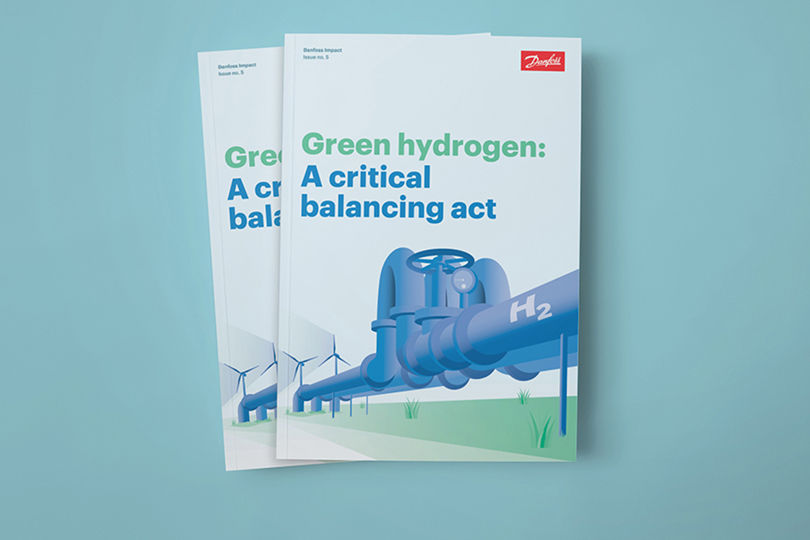
Danfoss Heat Exchangers are part of the world’s first large-scale commercial power-to-gas installation.
One of the big challenges in the green transition is how to store energy produced from solar and wind. Another is how to innovate new technologies which continue to lower our CO2 emissions.
Now, for the first time, a biogas plant has cracked the code on how to utilize green hydrogen while also saving on emissions in their total energy production.
The first large-scale commercial power-to-gas installation is up and running in Denmark. The electrolyzers are owned and operated by energy and fiber-network group Andel, while the green hydrogen is utilized by global biogas producer Nature Energy in their methanization processes.
Danfoss’ commercial partner Stiesdal Hydrogen 1) has delivered the electrolyzer units which produce hydrogen in an innovative way. The green hydrogen – that’s hydrogen which is produced by the electrolysis of water using renewable energy – is used in the biogas process. When green hydrogen meets CO2 in the methanization process, it converts to e-methane and thereby boosts biomethane output and reduces CO2.
Stiesdal Hydrogen approached Danfoss Heat Exchangers with an innovative design for their electrolyzer, featuring heat exchanger plates as the core component of the electrode cell stack. Danfoss’ in-house competencies within tools for customized plates and welding meant that within six months the first prototype of the electrolyzer electrode stack was in place. The collaboration between the two companies has led to the development of a high-performing electrode cell stack. The heat exchanger electrolyzers stack is the heart of the electrolyzer and splits water into oxygen and hydrogen.
This new innovation is very well suited for mass production, which is crucial for the increase in electrolyzer capacity needed in the global efforts to de-carbonize hard-to-abate sectors.
A unique alkaline electrolyzer
Modern electrolyzers use a variety of technologies to split water into hydrogen and oxygen. Stiesdal’s electrolyzer design is based on alkaline electrolysis. Alkaline technology has the advantage of operating at low temperatures and requiring no noble metals. Traditionally however, alkaline technology is seen as less suited for the variability of renewable energy sources. Through their collaboration, Stiesdal Hydrogen and Danfoss have been able to introduce a new class of alkaline electrolyzer with a highly dynamic range of operation, effectively following the availability of renewable energy and low electricity prices. When there is less green energy or the prices are too high, production is lowered. In this way, the plant helps balance the energy system.
We have built a system which is very flexible where we can adjust the production based on the sun and the wind. Hence, we want to produce hydrogen when the power is cheap. That is a different approach compared to how hydrogen units have been performing earlier on, as they have mostly been grid connected in a steady state continuous hydrogen production. With these units we see a large business potential as well as supporting the green transition
Typically, raw biogas consists of 60 percent methane and 40 percent CO2 2), however by injecting hydrogen into the methane process the utilization of biomass amount can be lifted to more than 90 percent biomethane. Since spring 2024, the plant has been operating at full capacity, generating hydrogen and boosting Nature Energy’s green gas production by 12,000 m3 per day. In comparison, a standard Danish one-family house consumes approximately 1,300-1,500 m3 of gas per year 3).
Biogas part of global decarbonization goals
The International Renewable Energy Agency, IRENA 4) , has concluded that “a profound and systematic transformation of the global energy system must occur within 30 years.” At the recent COP28 it was further concluded that the world is not doing enough to stay on the pathway to reach a maximum of 1.5C raise before 2050. Following COP28, it was formulated that to get back on track, the world needs see a tripling of renewables, doubling of energy efficiency, and a slashing of methane emissions by 75% in 2030 to reach the 1.5 degrees target. Further, biomethane will play a big part in the energy transition in Europe and transition from natural gas to greener alternatives. European green biogas production is expected to grow from 4.2 billion cubic meters in 2022 to 35 billion cubic meters in 2030 5).
I am incredibly impressed by the system that Stiesdal has developed, which basically is a definition of what COP and the IEA have stipulated, producing both renewable hydrogen and bio-methane in a very energy efficient manner. Heat exchanger design, which today is a core competency of Danfoss, fits right into Stiesdal’s needs for an energy efficient electrolyzer. I am proud to see what Stiesdal, Danfoss and other stakeholders have accomplished together over a short time frame and the results speak for themselves. I am also proud that Danfoss once again proves that we are an important technology leader and contributor to the much-needed energy transformation

Hydrogen White Paper:
A new Danfoss Impact paper reveals that with hydrogen production set to consume more than half of today’s electricity demand by 2050, energy efficiency in its production is paramount.
References:
1) Press release:
2) Source IEA:
3) Source nature Energy press release:
https://nature-energy.com/dk-da/nyheder/power-to-x-anlaeg-er-sat-i-drift
4) Source:
https://www.irena.org/Digital-Report/World-Energy-Transitions-Outlook-2023
5) Source:
https://www.europeanbiogas.eu/20-increase-in-biomethane-production-in-europe-shows-biogases-industry
Danfoss Hydrogen Paper:
https://cdn.sanity.io/files/5zabm86v/production/237c59eff8c7444ca03b2139d1ea56d4fcdd778c.pdf


